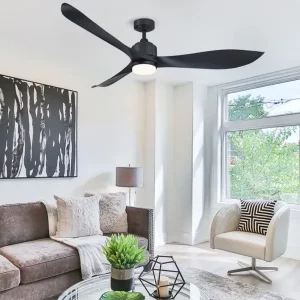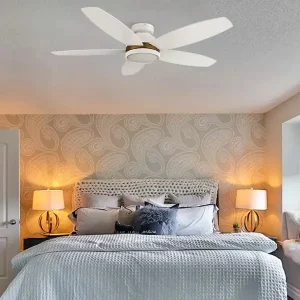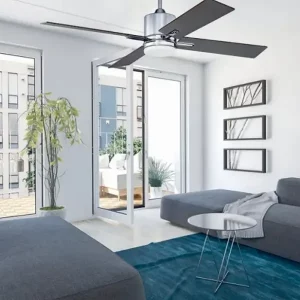Ceiling fans, unlike air conditioners, don’t cool the air but can make a room feel cooler while saving on energy costs. Using a ceiling fan, you can comfortably raise your thermostat a few degrees or even turn off your AC, reducing energy usage without losing comfort.
The primary function of a ceiling fan is straightforward: to circulate air efficiently and quietly. In our evaluations, we rate fans based on the air volume they move on both high and low settings, the noise level during operation, and any noise from the motor itself.
Basic Considerations
A wide range of ceiling fans are available, varying in style and finish. Our latest reviews focused on nine models with three speeds and a standard diameter of 52 inches, the most common size sold.
Fan Fundamentals. Fans are energy-efficient. Energy Star suggests saving 3 to 5 percent on air conditioning costs for each degree you increase your thermostat during summer days. Operating a ceiling fan, which is less costly than air conditioning, can make the temperature feel up to 4° F cooler. Remember to turn off the fan when not in the room as fans cool people, not spaces. Experiment with your thermostat, starting around 78° F and adjusting to find your comfort level.
Airflow and Noise Considerations. When selecting a fan, consider the cubic feet per minute (CFM) rating, which indicates air movement. Fans from previous CR tests have shown that airspeeds are comparable within a range of 5,000 to 5,600 CFM. Note that fans with significant airflow might also produce more noise, especially those with large, textured blades.
Stabilizing Your Fan. A common issue with ceiling fans is wobbling, which can usually be corrected with the included balancing kits. These kits have weights and clips that help balance the blades, significantly reducing wobble.
Selecting the Right Fan. Energy Star-rated fans and light kits are about 60 percent more efficient than non-rated options. Fans nowadays often come with integrated LED lights for better efficiency, although replacing incandescent bulbs in traditional fans with LED bulbs also saves energy.
Sizing Your Fan. The 52-inch fan works well in rooms between 225 to 400 square feet. For spaces 144 to 225 square feet, consider a 42- to 44-inch model. For rooms on the size threshold, opt for a more giant fan operated at a lower speed for quieter performance.
Style and Installation. Fans are available in various styles, from traditional to modern, and finishes like brass, bronze, and pewter. Blade shapes vary from flat paddles to unique designs like oval, leaf-shaped, or twisted blades. Install your fan centrally in the room at least 7 feet off the ground, or 8 to 9 feet for higher ceilings, to ensure optimal airflow. Ensure the fan’s blades are at least 24 inches from walls or curtains, and verify the ceiling electrical box can support the fan’s weight.
Outdoor and Damp-Rated Fans. For bathrooms, choose fans with a UL damp rating, and for outdoor areas like porches, look for fans with a UL wet rating. These fans feature moisture-resistant motors and rust-resistant components.
Lighting Options. Fans may come with integrated lights, or light kits might be available at the time of purchase or separately. Ensure any added light kit is compatible with your fan model. For fans with lighting, use dimmable LED bulbs if connected to a dimmer.
Matching Fan with Room Decor. Consider the fan as a piece of furniture that should complement the room’s décor. For high ceilings, use a downrod to position the fan appropriately. Matching the fan’s finish with other room elements, like flooring or metal fixtures, helps create a cohesive look.
By choosing the right ceiling fan, you can enhance your space’s comfort and style while being energy-efficient.



